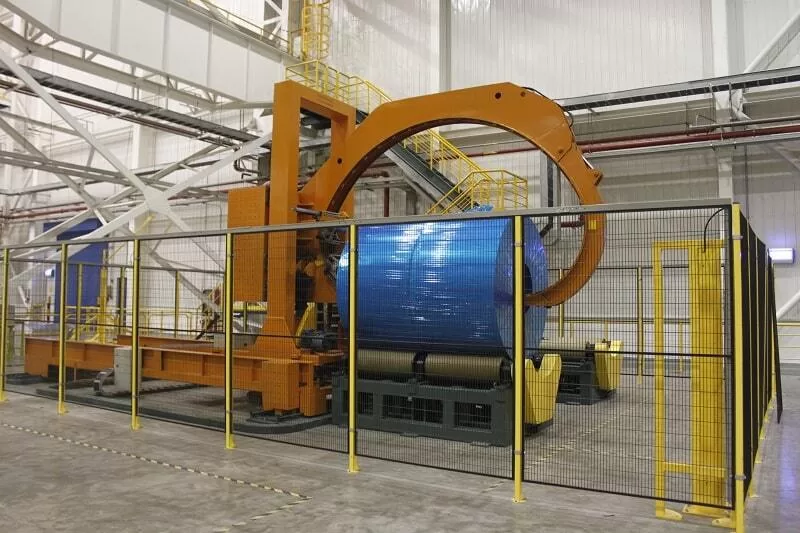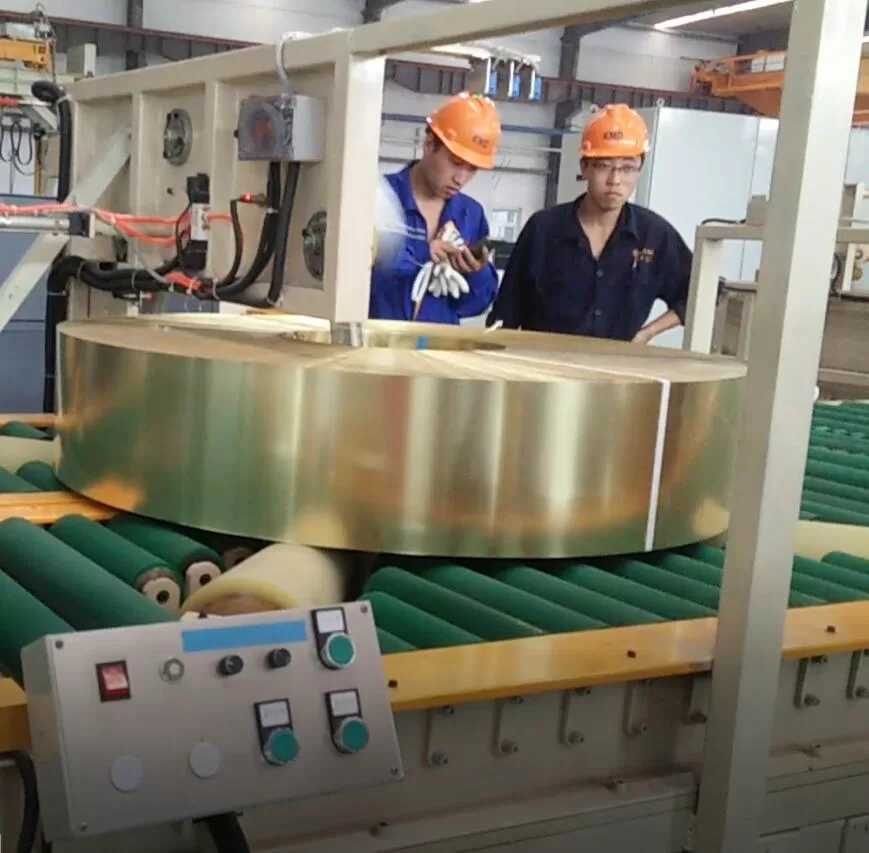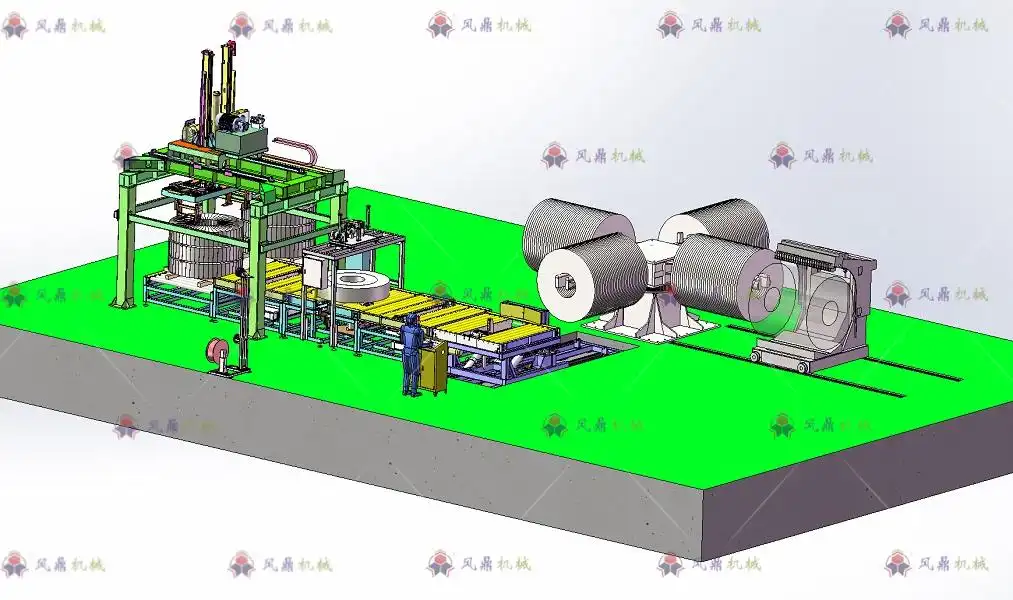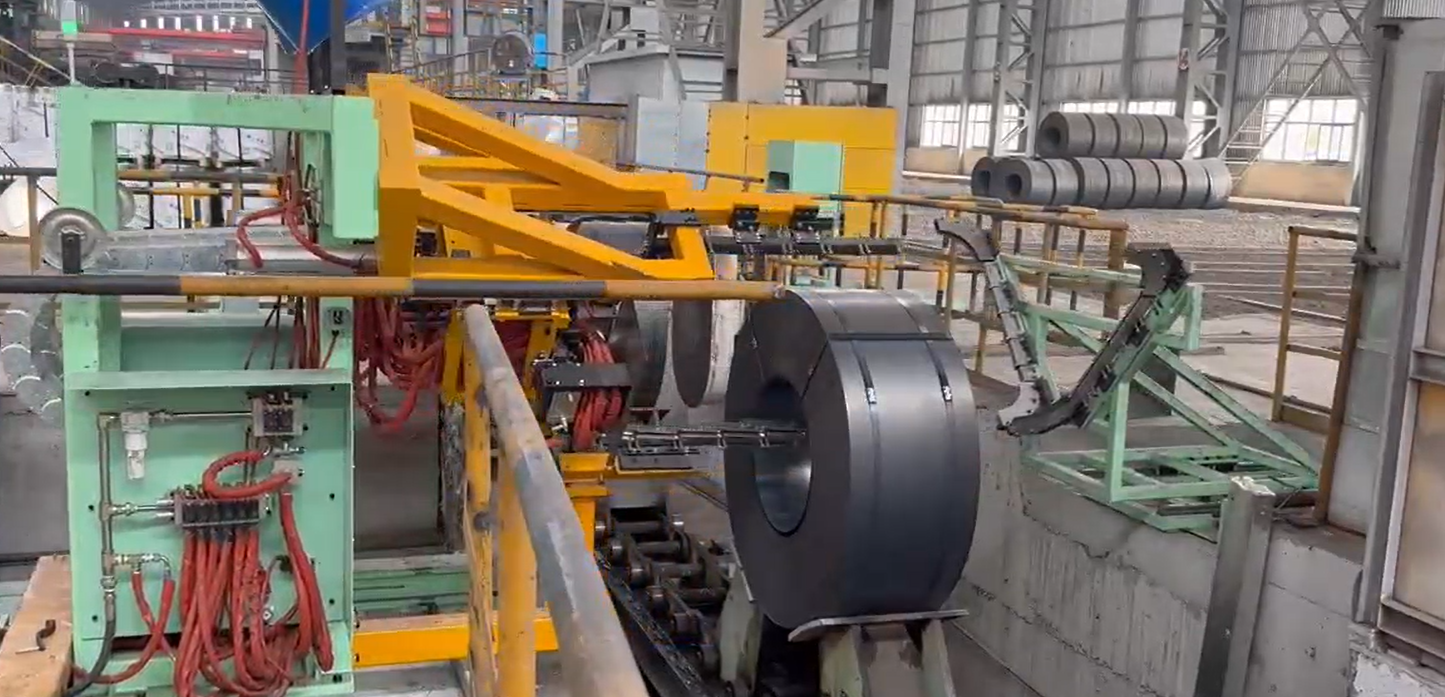Running a steel mill in Italy today is a constant balancing act. I know this because I've spent my entire career in the packing machine industry, first as an engineer and now as a factory owner. You're fighting against volatile energy costs, aging equipment, and intense market pressure. It feels like a thousand small cuts are draining your profitability. You focus on the big machinery, the furnaces and the rolling lines, but often the final step—logistics from packaging to the warehouse—is where hidden inefficiencies cause major bottlenecks. A poorly wrapped coil, a lost inventory tag, or a slow packaging line can halt your entire operation, turning hard-earned output into a logistical nightmare.
The solution is to stop thinking about packaging and warehousing as separate steps. Instead, you need to see them as one continuous, integrated system. An integrated solution connects your production output directly to your storage and shipping operations. It uses automation to handle, wrap, strap, and track every single coil seamlessly. This approach dramatically reduces manual errors, protects your product quality, and gives you the real-time data you need to make smart business decisions. It turns your logistics backend from a cost center into a competitive advantage.

This might sound complex, but the idea is simple. It's about creating a smooth flow. When a system is truly integrated, the machines communicate with each other. The data flows automatically. The result is less downtime, lower costs, and happier customers. Let's break down how this works in a practical sense and how it can solve the specific challenges you face every single day at your mill.
How Can Integrated Packaging Lines Solve Italy's Rising Labor Costs?
In Italy, as in many parts of Europe, finding and retaining skilled manual labor is becoming harder and more expensive. You rely on teams for packaging, but this work is repetitive, physically demanding, and carries safety risks. This dependency creates a major vulnerability in your operation. A sick team member or a holiday period can slow down your entire output, creating a bottleneck that ripples back through your production line. You are paying more for labor, but your throughput remains inconsistent, directly hurting your bottom line.
An integrated, automated packaging line is the direct answer to this challenge. It takes over the repetitive and strenuous tasks of coil handling, wrapping, and strapping. A well-designed line can run 24/7 with minimal human supervision. This frees your valuable team members to focus on higher-level tasks like quality control and system maintenance. It provides a predictable, consistent output that you can count on, day in and day out, without being subject to the volatility of the labor market.

The Shift from Manual Labor to Smart Automation
When I talk to steel mill owners like yourself, the conversation often turns to operational costs. Labor is always a top concern. An integrated packaging line addresses this head-on by automating a sequence of tasks that are inefficient and costly when done manually. It's not about a single machine; it's about a connected process.
The process starts the moment a coil comes off the production line.
- Automated Handling: Instead of a forklift driver trying to carefully pick up a heavy coil, an automated coil car or conveyor system transports it safely to the packaging station. This eliminates the risk of human error and product damage.
- Automatic Wrapping: The machine uses sensors to determine the coil's size and applies the wrapping material—whether it's stretch film or VCI paper—with perfect tension and overlap. This is something a manual team can never consistently replicate.
- Automatic Strapping: The system then applies steel or PET straps at precise, pre-programmed locations. This ensures the coil is secure for transport.
- Weighing and Labeling: An integrated scale captures the exact weight, and an automated printer applies a label with all necessary information, including a barcode or RFID tag for tracking.
This entire sequence happens without a single person needing to touch the coil. This dramatically changes the cost structure of your logistics.
Comparing Manual vs. Integrated Lines
Let's look at a direct comparison. It helps to see the numbers and the practical differences. The initial investment in automation can seem high, but the long-term operational savings and efficiency gains provide a clear return.
| Feature | Manual Packaging Line | Integrated Automated Line |
|---|---|---|
| Labor Required | 3-5 operators per shift | 1 supervisor per shift |
| Throughput | 5-10 coils per hour (variable) | 20-30 coils per hour (consistent) |
| Consistency | Low; depends on operator skill | High; machine precision |
| Safety Risk | High; manual lifting & handling | Very Low; operators are removed from danger |
| Data Entry | Manual; prone to errors | Automated; integrated with MES/ERP |
| Operating Hours | Limited by shift schedules | Can run 24/7 |
I remember a client in the steel wire sector who was hesitant. He saw the upfront cost and worried about the payback period. But his labor costs were rising 5% every year, and he couldn't find enough workers. After we installed an integrated line, he reduced his packaging team from twelve people across three shifts to just three supervisors. The payback period wasn't five years; it was just under two. The biggest surprise for him wasn't just the labor savings, but the fact that his entire plant's output increased because the packaging bottleneck was finally gone.
What Role Does Automation Play in Meeting Italy's Strict Quality Standards?
Your customers, especially those in the automotive and high-end manufacturing sectors, demand perfection. They have no tolerance for surface scratches, edge damage, or corrosion on their steel coils. A single rejected shipment not only costs you money in returns and replacements but also damages your hard-won reputation. You can produce the highest quality steel in your furnace, but if it gets damaged during packaging or transport, all that effort is wasted.
The problem is that manual handling is the number one cause of product damage. A tired forklift operator, an inconsistent wrap, or a loose strap can lead to catastrophic quality failures. You are constantly fighting to maintain quality, but the final, crucial step is left to chance. Automation removes this variability. It ensures that every coil is handled and packaged according to precise, repeatable standards. It applies protective materials flawlessly, secures the coil without causing damage, and minimizes exposure to the elements, guaranteeing your product arrives at the customer's door in the exact same condition it left your production line.

Building Quality into the Process
Quality should not be something you inspect for at the end. It should be built into every step of your process. This is a core principle for me as an engineer. In packaging logistics, automation is the tool that allows you to build in that quality. It moves beyond simple damage prevention and becomes an active part of your quality assurance system.
Here’s how an automated system systematically protects your product:
- Soft Handling: Automated coil cars and tilters use soft-touch materials and sensor-guided movements. They eliminate the jarring impacts and scrapes that are common with forklift tines.
- Controlled Wrapping Tension: Too little tension on the stretch film or VCI paper leaves gaps for moisture and dust. Too much tension can damage the coil's edges. An automated wrapper maintains the exact, optimal tension from the first wrap to the last, creating a perfect cocoon around your product.
- Precision Strapping: Straps must be tight enough to secure the coil but placed correctly to avoid damaging the edges. Automated strapping machines use sensors to find the perfect position and apply the exact amount of force needed, something that is nearly impossible for a human operator to do consistently.
The Hidden Costs of Poor Packaging Quality
Many mill owners I speak with underestimate the total cost of a quality failure in packaging. They see the cost of the returned product, but the true impact is much deeper. It’s a series of cascading costs that affect the entire business.
| Type of Cost | Description | How Automation Solves It |
|---|---|---|
| Direct Costs | Cost of scrap, freight for returns, rework labor. | Prevents initial damage, reducing scrap and returns to near zero. |
| Indirect Costs | Production line downtime while dealing with the issue, management time spent on customer complaints. | Consistent output and quality free up management to focus on growth, not firefighting. |
| Reputation Costs | Lost customer trust, potential loss of future contracts. This is the most damaging cost of all. | Delivers a perfectly packaged product every time, building a reputation for reliability and quality. |
| Inventory Costs | Damaged goods taking up valuable warehouse space. | Ensures all inventory is sellable, maximizing warehouse efficiency. |
A few years ago, I worked with a large Italian steel service center that supplied the automotive industry. They were getting frequent complaints about "edge rust" on their slitted coils. We investigated and found their manual wrapping process was inconsistent. Some workers pulled the VCI paper tighter than others, leaving microscopic gaps. Over the weeks of transit and storage, moisture would creep in. We installed a horizontal orbital wrapping machine with a top-press device. The machine applied the VCI film with computer-controlled precision. Their edge rust complaints dropped to zero within three months. The machine paid for itself not just in saved material, but in preserved contracts with their most important customers.
Can Smart Warehousing Systems Boost an Italian Steel Mill's Profitability?
You have a warehouse full of valuable steel coils, but when an order comes in, your team struggles to find the right one quickly. A truck is waiting, the customer is calling, and your staff is searching through rows of inventory with a clipboard. This chaos is a direct drain on your profitability. It leads to wasted labor, shipping delays, and sometimes even lost or misplaced inventory. You're trying to manage a multi-million-dollar inventory with an outdated system, which makes it impossible to respond quickly to the market fluctuations you face.
A smart warehousing system, fully integrated with your packaging line, solves this problem. It transforms your warehouse from a chaotic storage space into a dynamic, intelligent logistics hub. By automatically tracking every coil from the moment it is labeled, you gain complete visibility. This allows you to optimize storage space, dramatically reduce search and retrieval times, and eliminate shipping errors. The result is faster order fulfillment, lower operational costs, and a significant boost to your overall profitability.

The Path to an Intelligent Warehouse
Creating a smart warehouse isn't about buying a single piece of software. It's about connecting the physical flow of goods with a digital flow of information. This process begins at the end of the packaging line.
Key Technologies for Integration
-
Automated Labeling and Data Capture: As soon as a coil is wrapped and strapped, the integrated system weighs it and prints a durable label. This label contains a unique barcode or, for more advanced systems, an RFID tag. A scanner automatically reads this tag and sends the data—including weight, dimensions, grade, and production date—directly to your Warehouse Management System (WMS). This eliminates all manual data entry, which is a common source of critical errors.
-
Warehouse Management System (WMS): This is the brain of your smart warehouse. The WMS receives the data from the packaging line and instantly assigns the coil a specific storage location. It optimizes this placement based on factors like coil size, customer order, or expected shipping date. It keeps a real-time map of your entire inventory.
-
Automated Storage and Retrieval Systems (AS/RS): For the highest level of efficiency, an AS/RS can be used. These are automated cranes that take the coil from the conveyor and place it in the exact rack location assigned by the WMS. When an order is placed, the WMS directs the crane to retrieve the correct coil and bring it to the shipping bay.
From Data to Decisions
The real power of a smart warehouse is how it turns raw data into actionable business intelligence. This directly supports the goals of a forward-thinking CEO like Javier.
| Goal | How a Smart Warehouse Contributes |
|---|---|
| Increase Capacity Utilization | By providing real-time data on finished goods inventory, the WMS helps the MES (Manufacturing Execution System) to better plan production runs. You avoid overproducing items that will just sit in the warehouse. |
| Reduce Operating Costs | Labor costs for searching and moving inventory are drastically cut. Optimized storage increases warehouse capacity without physical expansion. Elimination of shipping errors avoids costly returns. |
| Improve Market Responsiveness | When a rush order comes in, you can instantly confirm if you have the stock and locate it in seconds. This agility is a powerful competitive advantage in a fluctuating market. |
| Advance Digital Transformation | It provides a rich source of data for analysis. You can track inventory turnover, identify slow-moving products, and optimize your entire supply chain. |
I've seen this transformation firsthand. A client was planning a massive warehouse expansion. Their existing space was completely full, and they thought they had no choice. Instead, we first focused on integrating their packaging line with a WMS. Once they had real-time visibility and optimized storage, they discovered that 20% of their warehouse space was being taken up by "lost" or misidentified coils. After implementing the system, they not only canceled the expansion project—saving millions in capital—but also improved their shipping times by 40%.
Why is a 'Total Solution' Approach Crucial for Future-Proofing Italian Steel Logistics?
You have likely experienced this problem before. You buy a wrapping machine from one company, a strapping machine from another, and a conveyor system from a third. On paper, each machine is top-of-the-line. But when you try to make them work together, the problems begin. The strapper doesn't get the signal from the wrapper. The conveyor speed isn't synced with the packaging output. When a problem occurs, each supplier blames the other, and you are stuck in the middle, trying to be an integrator instead of running your steel mill.
This patchwork approach is a short-term fix that creates long-term headaches. It makes your operations fragile and difficult to upgrade. A 'Total Solution' approach, on the other hand, is about designing the entire logistics system—from packaging to warehousing—to function as a single, cohesive unit. It means working with a strategic partner who takes responsibility for the entire project. This is crucial for future-proofing your business because it provides a stable, efficient, and scalable foundation that can grow and adapt with your needs.

The Strategic Value of a Single Partner
My own journey led me to create SHJLPACK based on this very principle. I started as an engineer in a factory. I saw companies spend good money on excellent individual machines, but their overall system was inefficient because the pieces didn't fit together. I knew there had to be a better way. A total solution partner does more than just sell equipment; they provide a comprehensive service that covers the entire lifecycle of your logistics system.
Multi-Supplier vs. Total Solution Partner
The difference in approach has a massive impact on your project's success and your long-term operational health.
| Aspect | Multi-Supplier Approach | Total Solution Partner |
|---|---|---|
| Design & Integration | Your responsibility. You must ensure all machines can communicate and work together. | The partner's responsibility. They design a fully integrated system from the start. |
| Project Management | Complex. You manage multiple vendors, timelines, and contacts. | Simplified. You have one point of contact for the entire project. |
| Commissioning & Startup | Often delayed due to integration issues between different suppliers' equipment. | Faster and smoother. The entire system is tested as a whole before installation. |
| Troubleshooting | "Finger-pointing." Each supplier may blame others for system failures. | Clear accountability. One partner is responsible for fixing any issue. |
| Future Upgrades | Difficult. Adding new technology requires complex re-integration. | Seamless. The system is designed with scalability and future upgrades in mind. |
| Total Cost of Ownership | Often higher due to integration costs, delays, and ongoing maintenance headaches. | Lower. An optimized, reliable system reduces downtime and long-term operational costs. |
Building for Tomorrow, Not Just Today
A total solution is not just about solving today's problems of aging equipment or high costs. It's about building a platform for future growth. An integrated system with a central control and data platform makes it much easier to implement future technologies like predictive maintenance, advanced analytics, and AI-driven optimization.
For instance, when all your packaging and handling data is collected in one place, you can start to see patterns. You can predict when a motor on a conveyor is likely to fail based on its energy consumption. You can analyze which packaging materials provide the best protection for specific shipping routes. This is how you move from a reactive to a proactive operation. It's how you build a business that is resilient enough to handle the cyclical nature of the steel industry and agile enough to seize new opportunities. This is the kind of strategic partnership that a forward-thinking leader needs to secure a competitive edge for the next decade.
My Insights
When I sit down with steel mill owners, I don't just see them as clients. I see them as fellow engineers and entrepreneurs. I understand the pressure you are under because I have lived it myself. My journey from being an employee on the factory floor to establishing my own successful packing machine business has taught me one crucial lesson: investment in smart automation is not an expense. It is a strategic investment in the stability and future of your business.
Many people focus only on the direct ROI—the labor savings or the reduced material costs. Those are important, and we can calculate them. But the real value, the one that leaders like you understand, is in the secondary benefits. It’s the improved quality that protects your brand reputation. It’s the operational stability that lets you sleep at night. It’s the agility to tell a major customer "yes, we can handle that rush order" because you know your system can deliver.
Automation is not about replacing your people. It's about elevating them. You move your team from doing dangerous, repetitive manual labor to overseeing sophisticated systems, analyzing data, and finding new ways to improve the process. You empower them to use their brains, not just their bodies. This creates a more engaged and valuable workforce.
The Italian steel industry has a proud history. To build a successful future, we must embrace integrated solutions that make our operations smarter, stronger, and more resilient. The path from packaging to the warehouse is the final, critical mile of your production process. Getting it right will define your profitability and competitiveness for years to come.
Conclusion
Integrating your logistics from packaging to warehouse is not just an upgrade. It is a fundamental shift toward a more efficient, profitable, and future-proof steel operation.




